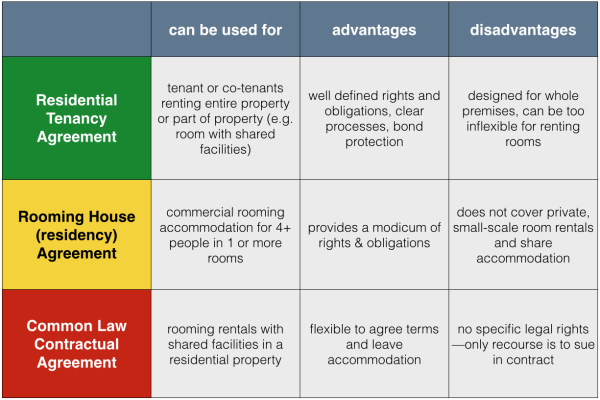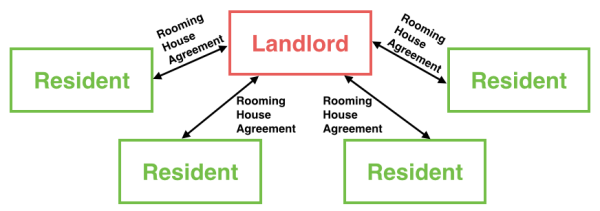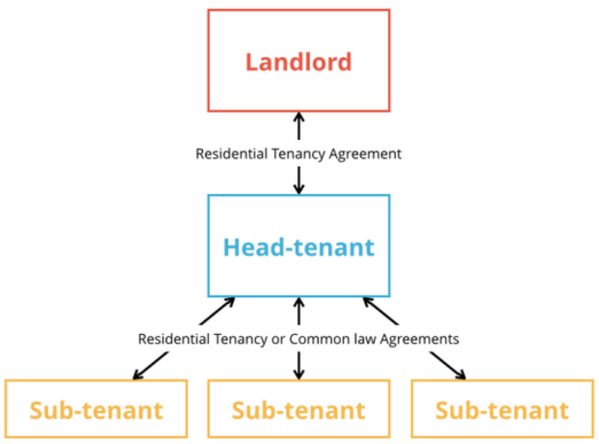What is my share accommodation situation? - Victoria
Understanding which laws apply to your agreement will help you know your rights and obligations. Flatmates recommends using residential tenancy agreements in most share accommodation situations.
What are the different types of share accommodation agreements?
In Victoria, there are 3 legal categories of agreement that can cover share accommodation. Knowing which one should apply to your situation is essential for understanding what the relevant rights and obligations are.

What type of agreement applies to my situation?
In Victoria, there are 5 common share accommodation situations. Different types of agreements apply to each situation. In most cases, a residential tenancy agreement should be used.
The 5 situations are:
1. Landlord rents entire property to single tenant

Type of Agreement: Residential Tenancy Agreement
This is the standard rental situation where one tenant rents an entire property (i.e. a house or apartment) from the landlord. Victorian tenancy law will automatically apply.
In this situation you should always use the standard form Residential Tenancy Agreement and the Rental Bond needs to be registered with the Residential Tenancies Bond Authority.
2. Landlord rents entire property to multiple co-tenants under one agreement

Type of Agreement: Residential Tenancy Agreement
This is common in share accommodation arrangement, where a group of co-tenants are listed on a single tenancy agreement. This situation is the same as a single tenant renting a whole property.
In this situation you should always use the standard form Residential Tenancy Agreement and the Rental Bond needs to be registered with the Residential Tenancies Bond Authority.
All co-tenants jointly share the same rights and obligations under the tenancy agreement. The division of rent is a matter of agreement between the co-tenants, but all co-tenants are jointly liable for the whole of the rental amount and any damages that occur to the property.
If an existing tenant (or co-tenants) wants to add another person to the agreement as a co-tenant, they must gain the landlord’s consent. The landlord cannot withhold consent unreasonably. Usually the landlord can only refuse consent if adding a new co-tenant would result in over-crowding or a breach of the tenancy agreement. To add a new co-tenant, you should add their name as a tenant to the existing tenancy agreement. Any changes should be initialed by the incoming tenant, outgoing tenant, and the landlord.
3. Landlord runs a registered rooming house with accommodation for 4 or more residents

Type of Agreement: Rooming House (residency) agreement
A Rooming House (residency) agreement should only be used when the landlord is renting 1 or more rooms with accommodation for 4 or more people in a registered rooming house.
In this situation, the resident (roomer) will usually occupy a room and have shared access to facilities such as bathrooms, laundries, or kitchens with other boarders.
Generally, rooming house agreements will only apply to commercial scale accommodation providers. If this applies to your situation, a separate contract should be signed by the landlord and each resident. The contract should be supplied by the landlord. Minimum standards apply for rooming houses in Victoria, which can be found at Consumer Affairs Victoria.
4. Sub-tenant rents a room from a head-tenant, with access to shared facilities

Type of Agreement: Residential Tenancy Agreement (recommended) or common law agreement (suggested: Flatmate Agreement)
This is another common share accommodation situation. The landlord rents the entire premises to the head-tenant under a residential tenancy agreement. The head-tenant then rents part of the premises to the sub-tenant. Under the sub-tenancy agreement, the sub-tenant usually has exclusive use of a bedroom and shared use of facilities like bathrooms and kitchens with the head-tenant.
The agreement between the head-tenant and sub-tenant can be classified as either a residential tenancy agreement or a common law agreement, depending on the exact circumstances. Flatmates strongly recommends using the standard form Residential Tenancy Agreement.
In this situation, the head-tenant is in effect the landlord to the sub-tenant. The agreement should clearly state the areas of the house that the sub-tenant has exclusive use of (e.g. bedroom) and shared use of (e.g. bathrooms, kitchens). Before the head-tenant can sub-let to a sub-tenant, they must gain the consent of the landlord. The landlord cannot unreasonably refuse to give consent. Usually, the only reason the landlord can refuse consent is if the sub-tenancy would result in overcrowding of the premises or a breach of the tenancy agreement with the head-tenant.
5. Live-in landlord rents rooms to 1-3 people on separate agreements, with access to shared facilities

Type of Agreement: Residential Tenancy Agreement (recommended) or common law agreement (suggested: Flatmate Agreement)
This is another common share accommodation situation. In these circumstances, the landlord lives at the premises and rents rooms to 1-3 people on separate agreements. Under each of these agreements, the tenant usually has exclusive use of a bedroom and shared use of facilities like bathrooms and kitchens with the landlord (and other tenants).
Each of the agreements can be classified as either a residential tenancy agreement or a common law agreement, depending on the exact circumstances. Flatmates strongly recommends using the standard form Residential Tenancy Agreement.
In this situation, it is important that the agreement clearly state the areas of the house that each tenant has exclusive use of (e.g. bedroom) and shared use of (e.g. bathrooms, kitchens).
Back to What is my Share Accommodation situation?
These legal guides provide a brief summary and introduction of the laws and regulations affecting share accommodation. They do not cover all cases in all legal jurisdictions and might not apply in your specific share accommodation situation. It is important that you use this information as a guide only and seek independent Legal Advice or consult the Relevant Acts. We do not accept any liability that may arise from the use of this information.